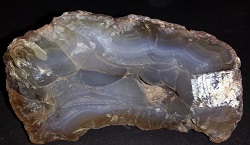A- |
B- |
C- |
D- |
E- |
F- |
G- |
H- |
I- |
J- |
K- |
L- |
M- |
N- |
O- |
P- |
Q- |
R- |
S- |
T- |
U- |
V- |
W- |
X- |
Y- |
Z |
AGATE:USES: Gemstone and ornamental stone.COLOR: Nearly any color, even colorless. The key is the presence of banding. HARDNESS: 7 CLEAVAGE: none CRYSTAL SYSTEM: none visible (actual crystals are microscopic) Agate is the term for banded chalcedony. It is often found as the layers lining geodes deposited in different colors as a quartz geode formed contained different impurities (or even none, resulting in a white or colorless band). As a general term, agate is so broadly descriptive that there are hundreds of names applied to varieties of agate from different localities. While many names reflect the source, some popular varieties are descriptive, such as "blue lace agate". Agate is primarily formed by the deposit of silica from solution; it is also a common method of fossilization, as the organic remains of some living thing are gradually replaced by quartz. "Agatized coral" from the Tampa Bay area is an excellent example, as are all of the specimens of petrified wood. Agate is only one of several chalcedony (cryptocrystalline quartz) varieties. The primary varieties are as follows: Agate is a banded variety (sometimes with translucent bands). Bloodstone is green with red speckles. Carnelian is yellow to orange. Chrysoprase is green. Flint is generally black with a fibrous microscopic structure. Jasper is any colorful agate. Onyx is black, white, or alternating black and white. Sard is yellow to brown. Sardonyx is banded, alternating sard and (usually white) onyx.
|

